List of missions to Mars
This is a list of the 50 spacecraft missions (including unsuccessful ones) relating to the planet Mars, such as orbiters and rovers.
| Decade |
|
|---|---|
| 1960s | 12 |
| 1970s | 11 |
| 1980s | 2 |
| 1990s | 6 |
| 2000s | 8 |
| 2010s | 6 |
| 2020s | 4 |
Missions
- Mission Type Legend
- Mission to MarsGravity assist, destination elsewhere
| Mission | Spacecraft | Launch Date | Operator | Mission Type[1] | Outcome[2] | Remarks | Carrier rocket[3] |
|---|---|---|---|---|---|---|---|
| 1M No.1 | 1M No.1 | 10 October 1960 | OKB-1 |
Flyby | Launch failure | Failed to achieve Earth orbit | Molniya |
| 1M No.2 | 1M No.2 | 14 October 1960 | OKB-1 |
Flyby | Launch failure | Failed to achieve Earth orbit | Molniya |
| 2MV-4 No.1 | 2MV-4 No.1 | 24 October 1962 | Flyby | Launch failure | Booster stage ("Block L") disintegrated in LEO | Molniya | |
| Mars 1 | Mars 1 (2MV-4 No.2) |
1 November 1962 | Flyby | Spacecraft failure | Communications lost before first flyby | Molniya | |
| 2MV-3 No.1 | 2MV-3 No.1 | 4 November 1962 | Lander | Launch failure | Never left LEO | Molniya | |
| Mariner 3 | Mariner 3 | 5 November 1964 | NASA |
Flyby | Launch failure | Payload fairing failed to separate | Atlas LV-3 Agena-D |
| Mariner 4 | Mariner 4 | 28 November 1964 | NASA |
Flyby | Successful | First successful flyby of Mars on 15 July 1965 | Atlas LV-3 Agena-D |
| Zond 2 | Zond 2 (3MV-4A No.2) |
30 November 1964 | Flyby | Spacecraft failure | Communications lost before flyby | Molniya | |
| Mariner 6 | Mariner 6 | 25 February 1969 | NASA |
Flyby | Successful | Atlas SLV-3C Centaur-D | |
| 2M No.521 | 2M No.521
(1969A)[4] |
27 March 1969 | Orbiter | Launch failure | Failed to achieve Earth orbit | Proton-K/D | |
| Mariner 7 | Mariner 7 | 27 March 1969 | NASA |
Flyby | Successful | Atlas SLV-3C Centaur-D | |
| 2M No.522 | 2M No.522
(1969B)[4] |
2 April 1969 | Orbiter | Launch failure | Failed to achieve Earth orbit | Proton-K/D | |
| Mariner 8 | Mariner 8 | 9 May 1971 | NASA |
Orbiter | Launch failure | Failed to achieve Earth orbit | Atlas SLV-3C Centaur-D |
| Kosmos 419 | Kosmos 419 (3MS No.170) |
10 May 1971 | Orbiter | Launch failure | Never left LEO; booster stage burn timer set incorrectly | Proton-K/D | |
| Mars 2 | Mars 2 (4M No.171) |
19 May 1971 | Orbiter | Successful | On November 27 it became in short sequence the second spacecraft to orbit another planet.[5] Operated for 362 orbits[6] | Proton-K/D | |
| Mars 2 lander (SA 4M No.171) |
Lander | Spacecraft failure | First lander to impact Mars. Deployed from Mars 2, failed to land during attempt on 27 November 1971.[7] | ||||
| Prop-M | Rover | Failure Lost with Mars 2 |
First rover to impact Mars. Lost when the Mars 2 lander crashed into the surface of Mars. | ||||
| Mars 3 | Mars 3 (4M No.172) |
28 May 1971 | Orbiter | Successful | On December 2 it became in short sequence the third spacecraft to orbit another planet.[5] Operated for 20 orbits[8][9] | Proton-K/D | |
| Mars 3 lander (SA 4M No.172) |
Lander | Partial success[10][11] | First lander to make a soft landing on Mars. Landed on 2 December 1971. First partial image (70 lines) transmitted showing "gray background with no details".[8] Contact lost 20 seconds after transmission started, 110 seconds after landing.[12][13] | ||||
| Prop-M | Rover | Carrier vehicle failed before rover was deployed | First rover to make a soft landing on another planet. 4.5 kg (9.9 lb) rover connected to the Mars 3 lander by a tether. Deployment status unknown due to loss of communications with the Mars 3 lander.[12] | ||||
| Mariner 9 | Mariner 9 | 30 May 1971 | NASA |
Orbiter | Successful[14] | First spacecraft to orbit another planet, two weeks ahead of Mars 2 on November 14.[5] Deactivated 516 days after entering orbit. | Atlas SLV-3C Centaur-D |
| Mars 4 | Mars 4 (3MS No.52S) |
21 July 1973 | Orbiter | Partial success[15] | Failed to perform orbital insertion burn. Returned photographs of Mars during flyby. | Proton-K/D | |
| Mars 5 | Mars 5 (3MS No.53S) |
25 July 1973 | Orbiter | Successful | Contact lost after 9 days in Mars orbit. Returned 180 frames | Proton-K/D | |
| Mars 6 | Mars 6 (3MP No.50P) |
5 August 1973 | Flyby | Successful | Flyby bus collected data.[16] | Proton-K/D | |
| Mars 6 lander | Lander | Spacecraft failure | Contact lost upon landing, atmospheric data mostly unusable. | ||||
| Mars 7 | Mars 7 (3MP No.51P) |
9 August 1973 | Flyby | Successful | Flyby bus collected data. | Proton-K/D | |
| Mars 7 lander | Lander | Spacecraft failure | Separated from coast stage prematurely, failed to enter Martian atmosphere. | ||||
| Viking 1 | Viking 1 orbiter | 20 August 1975 | NASA |
Orbiter | Successful | Operated for 1385 orbits. Entered Mars orbit on 19 June 1976. | Titan IIIE Centaur-D1T |
| Viking 1 lander | Lander | Successful | First successful Mars lander. Deployed from Viking 1 orbiter. Landed on Mars on 20 July 1976. Operated for 2245 sols. | ||||
| Viking 2 | Viking 2 orbiter | 9 September 1975 | NASA |
Orbiter | Successful | Operated for 700 orbits. Entered Mars orbit on 7 August 1976. | Titan IIIE Centaur-D1T |
| Viking 2 lander | Lander | Successful | Deployed from Viking 2 orbiter. Landed on Mars on September 1976. Operated for 1281 sols (11 April 1980). | ||||
| Phobos 1 | Phobos 1 (1F No.101) |
7 July 1988 | Orbiter | Spacecraft failure | Communications lost before reaching Mars; failed to enter orbit | Proton-K/D-2 | |
| DAS | Phobos lander | Failure Lost with Phobos 1 |
To have been deployed by Phobos 1 | ||||
| Phobos 2 | Phobos 2 (1F No.102) |
12 July 1988 | Orbiter | Mostly successful | Orbital observations successful, communications lost before lander deployment. | Proton-K/D-2 | |
| Prop-F | Phobos rover | Failure Lost with Phobos 2 |
To have been deployed by Phobos 2 | ||||
| DAS | Phobos lander | Failure Lost with Phobos 2 |
To have been deployed by Phobos 2 | ||||
| Mars Observer | Mars Observer | 25 September 1992 | NASA |
Orbiter | Spacecraft failure | Lost communications before orbital insertion | Commercial Titan III |
| Mars Global Surveyor | Mars Global Surveyor | 7 November 1996 | NASA |
Orbiter | Successful | Operated for ten years | Delta II 7925 |
| Mars 96 | Mars 96 (M1 No.520) (Mars-8)[4] |
16 November 1996 | Rosaviakosmos |
Orbiter Penetrators |
Spacecraft failure | Never left LEO | Proton-K/D-2 |
| Mars 96 lander | Lander | Failure Lost with Mars 96 |
Two Mars landers to have been deployed by Mars 96. | ||||
| Mars 96 lander | Lander | Failure Lost with Mars 96 | |||||
| Mars 96 penetrator | Penetrator | Failure Lost with Mars 96 |
Two Mars Penetrators to have been deployed by Mars 96. | ||||
| Mars 96 penetrator | Penetrator | Failure Lost with Mars 96 | |||||
| Mars Pathfinder | Mars Pathfinder | 4 December 1996 | NASA |
Lander | Successful | Landed at 19.13°N 33.22°W on 4 July 1997,[17] Last contact on 27 September 1997 | Delta II 7925 |
| Sojourner | Rover | Successful | First rover to operate on another planet. Operated for 84 days[18] | ||||
| Nozomi | Nozomi (PLANET-B) |
3 July 1998 | ISAS |
Orbiter | Spacecraft failure | Performed a Mars flyby. Later contact lost due to loss of fuel. | M-V |
| Mars Climate Orbiter | Mars Climate Orbiter | 11 December 1998 | NASA |
Orbiter | Spacecraft failure | Approached Mars too closely during orbit insertion attempt due to a software interface bug involving different units for impulse and either burned up in the atmosphere or entered solar orbit | Delta II 7425 |
| Mars Polar Lander / Deep Space 2 | Mars Polar Lander | 3 January 1999 | NASA |
Lander | Spacecraft failure | Failed to function after landing | Delta II 7425 |
| Deep Space 2 | Penetrator | Spacecraft failure | No data transmitted after deployment from MPL. | ||||
| Deep Space 2 | Penetrator | Spacecraft failure | |||||
| Mars Odyssey | Mars Odyssey | 7 April 2001 | NASA |
Orbiter | Operational | Expected to remain operational until 2025. | Delta II 7925 |
| Mars Express | Mars Express | 2 June 2003 | ESA |
Orbiter | Operational | Enough fuel to remain operational until 2035 | Soyuz-FG / Fregat |
| Beagle 2 | ESA | Lander | Lander failure | No communications received after release from Mars Express. Orbital images of landing site suggest a successful landing, but two solar panels failed to deploy, obstructing its communications. | |||
| Spirit | Spirit (MER-A) |
10 June 2003 | NASA |
Rover | Successful | Landed on 4 January 2004. Operated for 2208 sols |
Delta II 7925 |
| Opportunity | Opportunity (MER-B) |
8 July 2003 | NASA |
Rover | Successful | Landed on 25 January 2004. Operated for 5351 sols |
Delta II 7925H |
| Rosetta | Rosetta | 2 March 2004 | ESA |
Flyby
(Gravity assist) |
Successful | Flyby in February 2007 en route to 67P/Churyumov–Gerasimenko[19] | Ariane 5G+ |
| Philae | Flyby
(Gravity assist) |
Successful | |||||
| Mars Reconnaissance Orbiter | Mars Reconnaissance Orbiter | 12 August 2005 | NASA |
Orbiter | Operational | Entered orbit on 10 March 2006 | Atlas V 401 |
| Phoenix | Phoenix | 4 August 2007 | NASA |
Lander | Successful | Landed on 25 May 2008. End of mission 2 November 2008 |
Delta II 7925 |
| Dawn | Dawn | 27 September 2007 | NASA |
Flyby
(Gravity assist) |
Successful | Flyby in February 2009 en route to 4 Vesta and Ceres | Delta II 7925H |
| Fobos-Grunt / Yinghuo-1 | Fobos-Grunt | 8 November 2011 | Roskosmos |
Orbiter Phobos sample return |
Spacecraft failure | Never left LEO (intended to depart under own power) | Zenit-2M |
| Yinghuo-1 | CNSA |
Orbiter | Failure Lost with Fobos-Grunt |
To have been deployed by Fobos-Grunt | |||
| Mars Science Laboratory | Curiosity (Mars Science Laboratory) |
26 November 2011 | NASA |
Rover | Operational | Landed on 6 August 2012 | Atlas V 541 |
| Mars Orbiter Mission | Mars Orbiter Mission | 5 November 2013 | ISRO |
Orbiter | Successful | Entered orbit on 24 September 2014. Mission extended to 2022, where the mission concluded on September 27, 2022 after contact was lost.[20] | PSLV-XL |
| MAVEN | MAVEN | 18 November 2013 | NASA |
Orbiter | Operational | Orbit insertion on 22 September 2014[21] | Atlas V 401 |
| ExoMars 2016 | ExoMars Trace Gas Orbiter | 14 March 2016 | ESA/Roscosmos ESA/ |
Orbiter | Operational | Entered orbit on 19 October 2016 | Proton-M / Briz-M |
| Schiaparelli EDM lander | ESA |
Lander | Spacecraft failure | Carried by the ExoMars Trace Gas Orbiter. Although the lander crashed,[22][23] engineering data on the first five minutes of entry was successfully retrieved.[24][25] | |||
| InSight | InSight | 5 May 2018[26][27] | NASA |
Lander | Successful | Landed on 26 November 2018. Last contact 15 December 2022.[28] | Atlas V 401 |
| MarCO A | Flyby | Successful | Flyby 26 November 2018. Last contact 29 December 2018. | ||||
| MarCO B | Flyby | Successful | Flyby 26 November 2018. Last contact 4 January 2019. | ||||
| Emirates Mars Mission | Hope | 19 July 2020[29] | MBRSC |
Orbiter | Operational | Entered orbit on 9 February 2021.[30][31][32] | H-IIA |
| Tianwen-1 | Tianwen-1 orbiter | 23 July 2020[33][34] | CNSA |
Orbiter | Operational | Entered orbit on 10 February 2021 | Long March 5 |
| Tianwen-1 lander | Lander | Successful | Landed on 14 May 2021 | ||||
| Zhurong rover | Rover | Operational | Landed on 14 May 2021[35] Deployed by the Tianwen-1 lander on 22 May 2021. | ||||
| Tianwen-1 Remote Camera | Lander | Successful | Landed on 14 May 2021 Deployed by the Zhurong rover on 1 June 2021.[36] | ||||
| Tianwen-1 Deployable Camera 2[37] | Orbiter | Successful | Entered orbit on 10 February 2021, deployed 31 December 2021 | ||||
| Mars 2020 | Perseverance | 30 July 2020[38] | NASA |
Rover | Operational | Landed on 18 February 2021[39] | Atlas V 541 |
| Ingenuity | Helicopter | Operational | First aerodynamic flight on another planet. Landed with Perseverance rover on 18 February 2021.[40] Deployed from rover on 3 April 2021. First flight achieved on April 19, 2021.[41] | ||||
| Psyche | Psyche | 13 October 2023 | NASA |
Flyby (Gravity assist) |
Enroute | Gravity assist en route to 16 Psyche in May 2026[42] | Falcon Heavy |
Landing locations
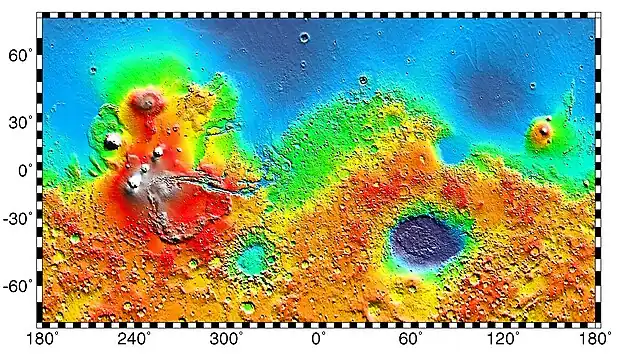
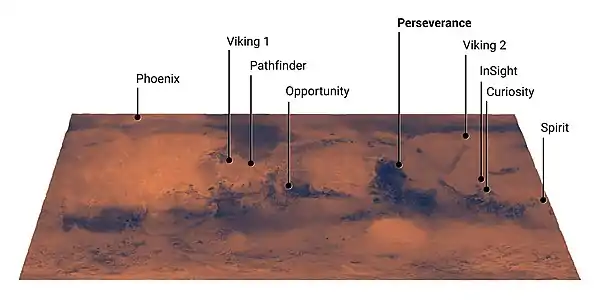
In 1999, Mars Climate Orbiter accidentally entered Mars' atmosphere and either burnt up or left Mars' orbit on an unknown trajectory.
There are a number of derelict spacecraft orbiting Mars whose location is not known precisely. There is a proposal to use the Optical Navigation Camera on the Mars Reconnaissance Orbiter to search for small moons, dust rings and old orbiters.[43] As of 2016, there were believed to be eight derelict spacecraft in orbit around Mars (barring unforeseen event).[44] The Viking 1 orbiter was not expected to decay until at least 2019.[45] Mariner 9, which entered Mars orbit in 1971, was expected to remain in orbit until approximately 2022, when it was projected to enter the Martian atmosphere and either burn up, or crash into the planet's surface.[46]
Timeline
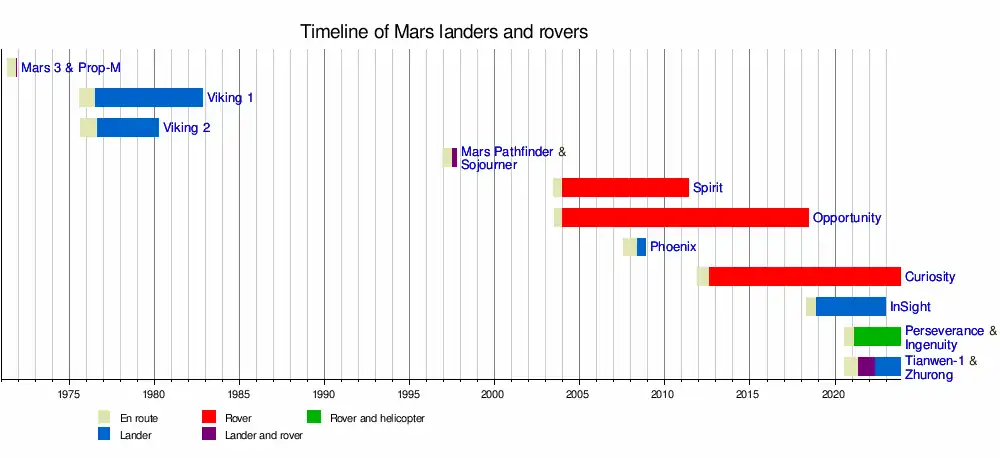
Missions to the moons of Mars
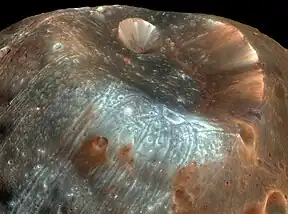
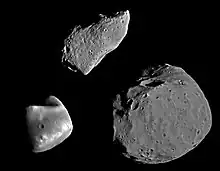
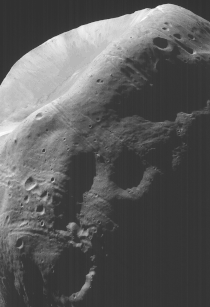
There have also have been proposed missions dedicated to explore the two moons of Mars, Phobos and Deimos. Many missions to Mars have also included dedicated observations of the moons, while this section is about missions focused solely on them. There have been three unsuccessful dedicated missions and many proposals. Because of the proximity of the Mars moons to Mars, any mission to them may also be considered a mission to Mars from some perspectives.
There have been at least three proposals in the United States Discovery Program, including PADME, PANDORA, and MERLIN.[48] The ESA has also considered a sample return mission, one of the latest known as Martian Moon Sample Return or MMSR, and it may use heritage from an asteroid sample return mission.[49]
| Proposal | Target | Reference |
|---|---|---|
| Aladdin | Phobos and Deimos | [50] |
| DePhine | Phobos and Deimos | [51] |
| DSR | Deimos | [52] |
| Gulliver | Deimos | [53] |
| Hall | Phobos and Deimos | [54] |
| M-PADS | Phobos and Deimos | [55] |
| Merlin | Phobos and Deimos | [56] |
| MMSR (2011 ver.) | Phobos or Deimos | [49] |
| OSRIS-REx 2 | Phobos or Deimos | [57] |
| Pandora | Phobos and Deimos | [48] |
| PCROSS | Phobos | [58] |
| Phobos Surveyor | Phobos | [59] |
| PRIME | Phobos | [60] |
| Fobos-Grunt 2 | Phobos | [61] |
| Phootprint | Phobos | [62][63] |
| PADME | Phobos and Deimos | [64][65] |
In Japan, the Institute of Space and Astronautical Science (ISAS) is developing a sample return mission to Phobos,[66][67] due to launch in 2024. This mission is called Martian Moons Exploration (MMX)[68] and is proposed as a flagship Strategic Large Mission.[69] MMX will build on the expertise the Japan Aerospace Exploration Agency (JAXA) would gain through the Hayabusa2 and SLIM missions.[70] As of January 2018, MMX is set for launch in September 2024.[71]
| Planned mission | Target | Reference |
|---|---|---|
| Martian Moons Exploration (MMX) | Phobos and Deimos | [68] |
Three missions to land on Phobos have been launched; the Phobos program in the late 1980s saw the launch of Fobos 1 and Fobos 2, while the Fobos-Grunt sample return mission was launched in 2011. None of these missions were successful: Fobos 1 failed en route to Mars, Fobos 2 failed shortly before landing, and Fobos-Grunt never left low Earth orbit.
| Launched mission | Target | Reference |
|---|---|---|
| Phobos 1 | Phobos | |
| Phobos 2 | Phobos | |
| Fobos-Grunt | Phobos |
Missions sent to the Martian system have returned data on Phobos and Deimos and missions specifically dedicated to the moons are a subset of missions Mars that often include dedicated goals to acquire data about these moons. An example of this is the imaging campaigns by Mars Express of the Mars moons.
Osiris-Rex 2 was a proposal to make OR a double mission, with the other one collecting samples from the two Mars moons.[72] In 2012, it was stated that this mission would be both the quickest and least expensive way to get samples from the Moons.[57]
The 'Red Rocks Project,' a part of Lockheed Martin's "Stepping Stones to Mars" program, proposed to explore Mars robotically from Deimos.[73][74]
Statistics
Mission milestone by country
- Legend
Achieved
Failed attempt
| Country | Flyby | Orbit | Lander | Rover | Powered flight | Phobos lander | Phobos rover | Phobos sample return |
|---|---|---|---|---|---|---|---|---|
| — | — | — | ||||||
| — | — | — | — | |||||
| — | — | |||||||
| — | — | — | ||||||
| — | — | — | — | — | ||||
| — | — | — | — | — | — | |||
| — | — | — | — | — | — | |||
| — | — | — | — | — | — | |||
| — | — | — | — | — | — |
Missions by organization/company
| Country | Agency or company | Successful | Partial failure | Failure | Operational | Gravity assist | Total |
|---|---|---|---|---|---|---|---|
| NASA | 13 | - | 5 | 4 | 1 | 23 | |
| Energia | 1 | 6 | 10 | - | - | 17 | |
| Roscosmos | - | 1 | 2 | - | - | 3 | |
| ESA | - | 2 | - | - | 1 | 3 | |
| CNSA | 1 | - | 1 | 1 | - | 2 | |
| ISRO | 1 | - | - | - | - | 1 | |
| UAESA | 1 | - | - | 1 | - | 1 | |
| ISAS | - | - | 1 | - | - | 1 |
Future missions
Under development
| Mission | Organization | Launch Date | Type |
|---|---|---|---|
| Martian Moons Exploration (MMX) Phobos Sample Return Mission | JAXA |
September 2024[75][76] | Orbiter/Lander |
| Escape and Plasma Acceleration and Dynamics Explorer mission (ESCAPADE)
Photon Blue and Gold |
NASA |
October 2024[77] | 2 Orbiters |
| Mars Orbiter Mission 2 | ISRO |
NET 2024[78][79] | Orbiter[80][81] |
| Tianwen-2 / ZhengHe Asteroid Sample Return Mission[82] | CNSA |
2025[83][84] | 2027 flyby en route to 311P/PANSTARRS |
| Tianwen-3 Mars sample-return mission | CNSA |
2028[85] | Two spacecrafts: one consists of orbiter and return module, the other lander, ascent module and a mobile sampling robot. Expected sample return: July 2031[86] |
| TEREX-1[87] | NICT, ISSL |
Mid 2020s | Orbiter |
| Rosalind Franklin rover | ESA |
2028 | Rover |
Proposed missions
Unrealized concepts
1970s
- Mars 4NM and Mars 5NM – projects intended by the Soviet Union for heavy Marsokhod (in 1973 according to initial plan of 1970) and Mars sample return (planned for 1975). The missions were to be launched on the failed N1 rocket.[95]
- Mars 5M (Mars-79) – double-launching Soviet sample return mission planned to 1979 but cancelled due to complexity and technical problems
- Voyager-Mars – USA, 1970s – Two orbiters and two landers, launched by a single Saturn V rocket.
1990s
- Vesta – the multiaimed Soviet mission, developed in cooperation with European countries for realisation in 1991–1994 but canceled due to the Soviet Union disbanding, included the flyby of Mars with delivering the aerostat and small landers or penetrators followed by flybys of 1 Ceres or 4 Vesta and some other asteroids with impact of penetrator on the one of them.
- Mars Aerostat – Russian/French balloon part for cancelled Vesta mission and then for failed Mars 96 mission,[96] originally planned for the 1992 launch window, postponed to 1994 and then to 1996 before being cancelled.[97]
- Mars Together, combined U.S. and Russian mission study in the 1990s. To be launched by a Molniya with possible U.S. orbiter or lander.[98][99]
- Mars Environmental Survey – set of 16 landers planned for 1999–2009
- Mars-98 – Russian mission including an orbiter, lander, and rover, planned for 1998 launch opportunity as repeat of failed Mars 96 mission; cancelled due to lack of funding
2000s
- Mars Surveyor 2001 Lander – October 2001 – Mars lander (refurbished, became Phoenix lander)
- Kitty Hawk – Mars airplane micromission, proposed for 17 December 2003, the centennial of the Wright brothers' first flight.[100] Its funding was eventually given to the 2003 Mars Network project.[101]
- NetLander – 2007 or 2009 – Mars netlanders
- Beagle 3 – 2009 British lander mission meant to search for life, past or present.
- Mars Telecommunications Orbiter – September 2009 – Mars orbiter for telecommunications
2010s
- Mars One - announced in 2012, planned to land a demo lander on Mars by 2016, with a crewed landing to follow by 2023. These dates were delayed multiple times, and the project was eventually cancelled, with the company going bankrupt in 2019
- Sky-Sailor – 2014 – Plane developed by Switzerland to take detailed pictures of Mars surface
- Mars Astrobiology Explorer-Cacher – 2018 rover concept, cancelled due to budget cuts in 2011. Sample cache goal later moved to Mars 2020 rover.[102]
- Red Dragon – Derivative of a Dragon 2 capsule by SpaceX, designed to land by aerobraking and retropropulsion. Planned for 2018, then 2020. Canceled in favor of the Starship system.
- Tumbleweed rover, wind-propelled sphere[103]
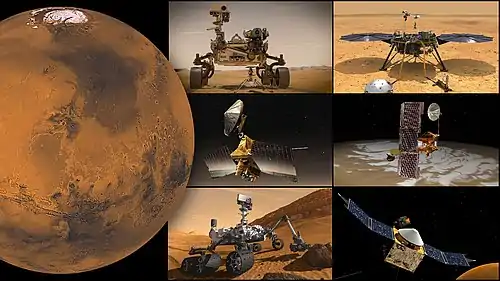
(Perseverance rover/Ingenuity Mars Helicopter; InSight lander; Mars Reconnaissance Orbiter; Odyssey orbiter; Curiosity rover; MAVEN orbiter)
References
- Chronology of Mars Exploration. NASA. Retrieved on 1 December 2011.
- "Pathfinder Rover Gets Its Name".
- "Russia's unmanned missions to Mars". www.russianspaceweb.com. Retrieved 12 February 2021.
- "Chronology of Mars Missions". ResearchGate. doi:10.13140/rg.2.2.29797.65768. Archived from the original on 10 December 2018.
- Smith, Kiona N. (30 May 2017). "The Mariner 9 Spacecraft And The Race To Orbit Mars". Forbes. Retrieved 16 February 2022.
- "Missions to Mars". The Planetary Society.
- NASA Space Science Data Center, Mars 2 Lander. Retrieved 11 Feb. 2021.
- Perminov, V.G. (July 1999). The Difficult Road to Mars - A Brief History of Mars Exploration in the Soviet Union. NASA Headquarters History Division. pp. 34–60. ISBN 0-16-058859-6.
- Webster, Guy (11 April 2013). "NASA Mars Orbiter Images May Show 1971 Soviet Lander". NASA. Retrieved 12 April 2013.
- "Mars 3 Lander". NASA.
Mars 3 was the first spacecraft to make a successful soft landing on Mars.
- "The First Rover on Mars - The Soviets Did It in 1971". Planetary Society.
The Mars 2 and 3 rover, which landed on Mars in 1971.
- "Mars 3 Spacecraft and Subsystems, NSSDCA cat". Retrieved 11 February 2021.
- NASA Space Science Data Center, Mars 3 Lander. Retrieved 11 Feb. 2021.
-
Pyle, Rod (2012). Destination Mars. Prometheus Books. pp. 73–78. ISBN 978-1-61614-589-7.
It was the first spacecraft to enter orbit around another world.
- "Soviet Mars Images".
- NSSDC - Mars 6
- "Mars Pathfinder Science Results". NASA. Archived from the original on 2 April 2012. Retrieved 20 September 2015.
- "Mars Pathfinder Welcome to Mars Sol 86 (1 October 1997) Images". 1 October 1997. Retrieved 12 February 2021.
- "ESA - Beautiful new images from Rosetta's approach to Mars: OSIRIS UPDATE". Esa.int. 24 February 2007. Retrieved 16 January 2012.
- Ray, Kalyan (8 February 2017). "Isro-Mars orbiter mission life extended up to 2020". Deccan Herald. Retrieved 12 February 2021.
- Brown, Dwayne; Neal-Jones, Nancy; Zubritsky, Elizabeth (21 September 2014). "NASA's Newest Mars Mission Spacecraft Enters Orbit around Red Planet". NASA. Retrieved 22 September 2014.
- Clark, Stephen (24 May 2017). "Probe into crash of ESA lander recommends more checks on ExoMars descent craft". Spaceflight Now. Retrieved 21 November 2018.
- "Weak Simulations, Inadequate Software & Mismanagement caused Schiaparelli Crash Landing". Spaceflight101. 24 May 2017. Retrieved 21 November 2018.
- Chan, Sewell (20 October 2016). "No Signal From Mars Lander, but European Officials Declare Mission a Success". New York Times. Retrieved 20 October 2016.
- Wall, Mike (21 October 2016). "ExoMars '96 Percent' Successful Despite Lander Crash: ESA". Space.com. Retrieved 21 October 2016.
- Clark, Stephen (9 March 2016). "InSight Mars lander escapes cancellation, aims for 2018 launch". Spaceflight Now. Retrieved 9 March 2016.
- Chang, Kenneth (9 March 2016). "NASA Reschedules Mars InSight Mission for May 2018". New York Times. Retrieved 9 March 2016.
- "NASA InSight – Dec. 19, 2022 – Mars InSight". blogs.nasa.gov. 19 December 2022. Retrieved 20 December 2022.
- "Live coverage: Launch of Emirates Mars Mission rescheduled for Sunday". Spaceflight Now. 14 July 2020. Retrieved 19 July 2020.
- "UAE's 'Hope' probe to be first in trio of Mars missions". Phys.Org. 7 February 2021. Retrieved 8 February 2021.
- "UAE's Hope Probe on its Way to Glory". 9 February 2021. Retrieved 3 March 2021.
- "The UAE's Hope Probe has successfully entered orbit around Mars". cnn.com. 9 February 2021. Retrieved 9 February 2021.
- Amos, Jonathan (23 July 2020). "China's Mars rover rockets away from Earth". BBC News. Retrieved 23 July 2020.
- "天外送祝福,月圆迎华诞——天问一号以"自拍国旗"祝福祖国71华诞". Weixin Official Accounts Platform. Retrieved 1 October 2020.
- "CGNT on twitter". 14 May 2021. Retrieved 14 May 2021.
China's Tianwen-1 probe lands on
- "The scientific image map was unveiled, and it was a one-time tour! my country's first Mars exploration mission was a complete success". Retrieved 6 June 2021.
The picture of the "touring group photo" shows the rover traveling about 10 meters south of the landing platform, releasing the separate camera installed at the bottom of the vehicle, and then retreating to the vicinity of the landing platform.
- "New Year's Day greetings-China National Space Administration releases the images returned by the Tianwen-1 probe". 1 January 2022.
- "Nasa Mars rover: Perseverance launches from Florida". BBC News. 30 July 2020. Retrieved 30 July 2020.
- mars.nasa.gov. "Mars 2020 Perseverance Rover". mars.nasa.gov. Retrieved 30 July 2020.
- "Mars Helicopter". NASA Mars. Retrieved 30 July 2020.
A technology demonstration to test the first powered flight on Mars.
- First Flight of the Ingenuity Mars Helicopter: Live from Mission Control. NASA. 19 April 2021. Retrieved 19 April 2021 – via YouTube.
- "NASA launches a spacecraft to visit Psyche, an unseen metal world". 13 October 2023.
- Adler, Mark; Owen, W.; Riedel, J. "Concepts and Approaches for Mars Exploration (2012)" (PDF). Retrieved 12 February 2021.
- "A Chronology of Mars Exploration". NASA. Retrieved 12 February 2021.
- "Viking 1 Orbiter". NASA. Retrieved 12 February 2021.
- NASA - This Month in NASA History: Mariner 9, 29 November 2011 – Vol. 4, Issue 9
- "JPL". Jet Propulsion Laboratory.
- MERLIN: The Creative Choices Behind a Proposal to Explore the Martian Moons (Merlin and PADME info also)
- Michel, P.; Agnolon, D.; Brucato, J.; Gondet, B.; Korablev, O.; Koschny, D.; Schmitz, N.; Willner, K.; Zacharov, A. (2 October 2011). "MMSR - a study for a Martian Moon Sample Return mission". Astrophysics Data System. 2011: 849. Bibcode:2011epsc.conf..849M. Retrieved 12 February 2021.
- "ALADDIN: PHOBOS-DEIMOS SAMPLE RETURN" (PDF). Universities Space Research Association. Retrieved 12 February 2021.
- DePhine: The Deimos and Phobos Interior Explorer. (PDF) Jurgen Oberst, Kai Wickhusen, Konrad Willner, Klaus Gwinner, Sofya Spiridonova, Ralph Kahle, Andrew Coates, Alain Herique, Dirk Plettemeier, Marina Dıaz-Michelena, Alexander Zakharo, Yoshifumi Futaana, Martin Patzold, Pascal Rosenblatt, David J. Lawrence, Valery Lainey, Alison Gibbings, Ingo Gerth. Advances in Space Research. Volume 62, Issue 8. pp: 2220-2238. 15 October 2018. doi:10.1016/j.asr.2017.12.028
- Renton, D.C (26 April 2005). "SMALL BODY SAMPLE RETURN TO DEIMOS". ESA. Retrieved 12 February 2021.
- Britt, D. "The Gulliver Mission: Sample Return from Deimos" (PDF). European Planetary Science Congress. Retrieved 12 February 2021.
- P. Lee, et al. - Hall: A Phobos and Deimos Sample Return Mission Archived 29 July 2012 at the Wayback Machine
- Mars Phobos and Deimos Survey (M-PADS)–A Martian Moons Orbiter and Phobos Lander (Ball, Andrew J.; Price, Michael E.; Walker, Roger J.; Dando, Glyn C.; Wells, Nigel S. and Zarnecki, John C. (2009). Mars Phobos and Deimos Survey (M-PADS)–A Martian Moons Orbiter and Phobos Lander. Advances in Space Research, 43(1), pp. 120–127.)
- Murchie, S.; Eng, D.; Chabot, N.; Guo, Y.; Arvidson, R.; Yen, A.; Trebi-Ollennu, A.; Seelos, F.; Adams, E.; Fountain, G. (2014). "MERLIN: Mars-Moon Exploration, Reconnaissance and Landed Investigation". Acta Astronautica. 93: 475–482. Bibcode:2014AcAau..93..475M. doi:10.1016/j.actaastro.2012.10.014.
- Elifritz, T.L (2012). "OSIRIS-REx II to Mars — Mars Sample Return from Phobos and Deimos". Astrophysics Data System. 1679: 4017. Bibcode:2012LPICo1679.4017E. Retrieved 12 February 2021.
- PCROSS, Phobos Close Rendevous [sic] Observation Sensing Satellite, Colaprete, A, et al.
- Fischer, Maria (16 January 2013). "Mothership and her Hedgehogs: New Concept for Exploring Phobos". Space Safety Magazine. Retrieved 12 February 2021.
- PRIME Archived 10 May 2008 at the Wayback Machine
- Pultarova, Tereza (22 October 2012). "Phobos-Grunt 2 Bound for Launch in 2020, Russians Confirmed While Celebrating Sputnik". Space Safety Magazine. Retrieved 12 February 2021.
- Barraclough, Simon; Ratcliffe, Andrew; Buchwald, Robert; Scheer, Heloise; Chapuy, Marc; Garland, Martin (16 June 2014). Phootprint: A European Phobos Sample Return Mission (PDF). 11th International Planetary Probe Workshop. Airbus Defense and Space. Archived from the original (PDF) on 29 January 2016. Retrieved 22 December 2015.
- Koschny, Detlef; Svedhem, Håkan; Rebuffat, Denis (2 August 2014). "Phootprint - A Phobos sample return mission study". ESA. 40: B0.4–9–14. Bibcode:2014cosp...40E1592K.
- Lee, Pascal; Bicay, Michael; Colapre, Anthony; Elphic, Richard (17–21 March 2014). Phobos And Deimos & Mars Environment (PADME): A LADEE-Derived Mission to Explore Mars's Moons and the Martian Orbital Environment (PDF). 45th Lunar and Planetary Science Conference (2014).
- Reyes, Tim (1 October 2014). "Making the Case for a Mission to the Martian Moon Phobos". Universe Today. Retrieved 5 October 2014.
- "Introduction to JAXA's Exploration of the Two Moons of Mars, with Sample Return from Phobos" (PDF). Phobos/Deimos Sample Return Mission Study Team. 26 October 2015. Retrieved 22 December 2015.
- "JAXA、火星衛星「フォボス」探査…22年に". The Yomiuri Shimbun (in Japanese). 4 January 2016. Archived from the original on 4 January 2016. Retrieved 4 February 2016.
- "ISASニュース 2016.1 No.418" (PDF) (in Japanese). Institute of Space and Astronautical Science. 22 January 2016. Retrieved 4 February 2016.
- 宇宙科学・探査分野 工程表取り組み状況について その3 (PDF) (in Japanese). Japanese Aerospace Exploration Agency. 13 October 2015. Retrieved 21 December 2015.
- Torishima, Shinya (19 June 2015). "JAXAの「火星の衛星からのサンプル・リターン」計画とは". Mynavi News (in Japanese). Retrieved 6 October 2015.
- MMX Homepage Archived 5 October 2017 at the Wayback Machine. JAXA, 2017
- Elifritz, T.L. "OSIRIS-REx II to Mars - Mars Sample Return from Phobos and Deimos - A Mars Mission Proposal" (PDF). Universities Space Research Association. Retrieved 12 February 2021.
- Larry Page Deep Space Exploration - Stepping Stones builds up to "Red Rocks : Explore Mars from Deimos"
- David, Leonard (20 April 2011). "One Possible Small Step Toward Mars Landing: A Martian Moon". Space.com. Retrieved 12 February 2021.
- NASA confirms contribution to Japanese-led Mars mission. Stephen Clark, Space Flight Now. 20 November 2017.
- Back to the Red Planet Archived 27 March 2018 at the Wayback Machine. Johns Hopkins APL. 17 November 2017.
- Sanders, Robert (23 August 2021). "'Blue' and 'Gold' satellites headed to Mars in 2024". UC Berkeley. Retrieved 24 August 2021.
- "Episode 90 – An update on ISRO's activities with S Somanath and R Umamaheshwaran". AstrotalkUK. 24 October 2019. Retrieved 30 October 2019.
- Jatiya, Satyanarayan (18 July 2019). "Rajya Sabha Unstarred Question No. 2955" (PDF). Retrieved 18 July 2019. Alt URL
- "India's next Mars mission likely to be an orbiter". The Week. Retrieved 20 February 2021.
- "Isro says India's second Mars mission Mangalyaan-2 will be an orbiter mission". India Today. 20 February 2021. Retrieved 20 February 2021.
- Jones, Andrew (18 May 2021). "China to launch Tianwen 2 asteroid-sampling mission in 2025". Space.com. Retrieved 23 June 2022.
- Jones, Andrew (10 August 2021). "China Plans Near-Earth Asteroid Smash-and-Grab". spectrum.ieee.org. Retrieved 10 August 2021.
- Zhang, Xiaojing; Huang, Jiangchuan; Wang, Tong; Huo, Zhuoxi (18–22 March 2019). ZhengHe – A Mission to a Near-Earth Asteroid and a Main Belt Comet (PDF). 50th Lunar and Planetary Science Conference. Retrieved 4 June 2019.
- Jones, Andrew (20 June 2022). "China aims to bring Mars samples to Earth 2 years before NASA, ESA mission". spacenews.com. Retrieved 23 June 2022.
- Jones, Andrew (30 June 2021). "China outlines space plans to 2025". spacenews.com. Retrieved 30 June 2021.
- 惑星資源探査 ⼩型テラヘルツ探査機 (PDF) (in Japanese). National Institute of Information and Communications Technology. 25 January 2017. Retrieved 13 May 2017.
- Henry, Caleb (24 October 2019). "Virgin Orbit to add extra rocket stage to LauncherOne for interplanetary missions". SpaceNews. Retrieved 31 August 2021.
- O'Callaghan, Jonathan (9 October 2019). "Virgin Orbit Is Planning An Ambitious Mission To Mars In 2022". Forbes. Retrieved 31 August 2021.
- Foust, Jeff (21 September 2023). "NASA Mars Sample Return budget and schedule "unrealistic," independent review concludes". spacenews.com. Retrieved 27 September 2023.
- Foust, Jeff (28 March 2022). "NASA to delay Mars Sample Return, switch to dual-lander approach". spacenews.com. Retrieved 28 March 2022.
- Clark, Stephen (9 April 2018). "NASA is counting on long-lived Mars orbiter lasting another decade". Spaceflight Now. Retrieved 22 April 2018.
- Stephen, Clark (3 March 2015). "NASA eyes ion engines for Mars orbiter launching in 2022". Space Flight Now. Retrieved 5 March 2015.
- Foust, Jeff (28 March 2022). "White House requests $26 billion for NASA for 2023". spacenews.com. Retrieved 1 April 2022.
- Советский грунт с Марса (in Russian). novosti-kosmonavtiki.ru Archived 26 November 2005 at the Wayback Machine
- C. Tarrieu, "Status of the Mars 96 Aerostat Development", Paper IAF-93-Q.3.399, 44th Congress of the International Astronautical Federation, 1993.
- P.B. de Selding, "Planned French Balloon May Be Dropped", Space News, 17–23 April 1995, pp. 1, 20
- "Mars Together Update". nasa.gov. Retrieved 9 February 2017.
- "Mars Together: An Update". nasa.gov. Retrieved 9 February 2017.
- Oliver Morton in To Mars, En Masse, pp. 1103–04, Science (Magazine) vol. 283, 19 February 1999, ISSN 0036-8075
- MIT Mars Airplane Project. Marsnews.com. Retrieved on 14 August 2012.
- O'Rourke, Joseph (9 September 2014). "Instruments selected for Mars 2020, NASA's latest rover". Astrobites.org. Retrieved 12 February 2021.
- Exploring Mars: Blowing in the Wind? Archived 16 April 2021 at the Wayback Machine Jpl.nasa.gov (10 August 2001). Retrieved on 2012-08-14.

.jpg.webp)
.jpg.webp)